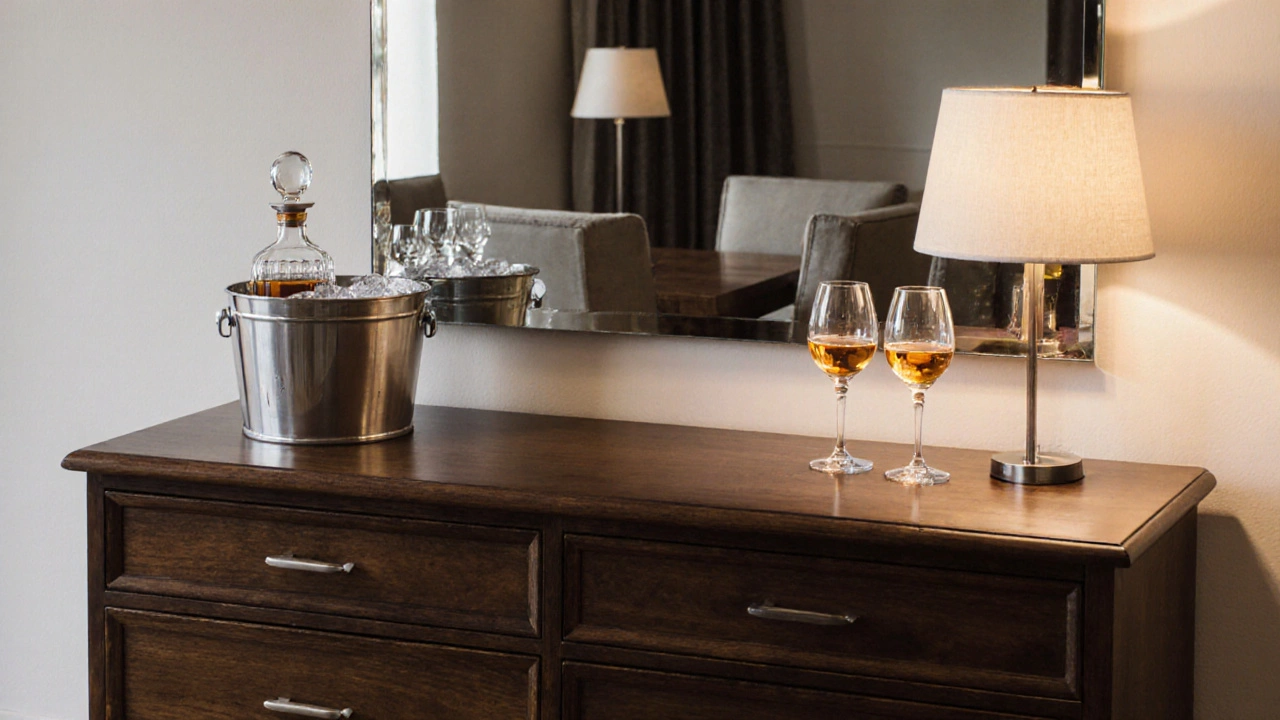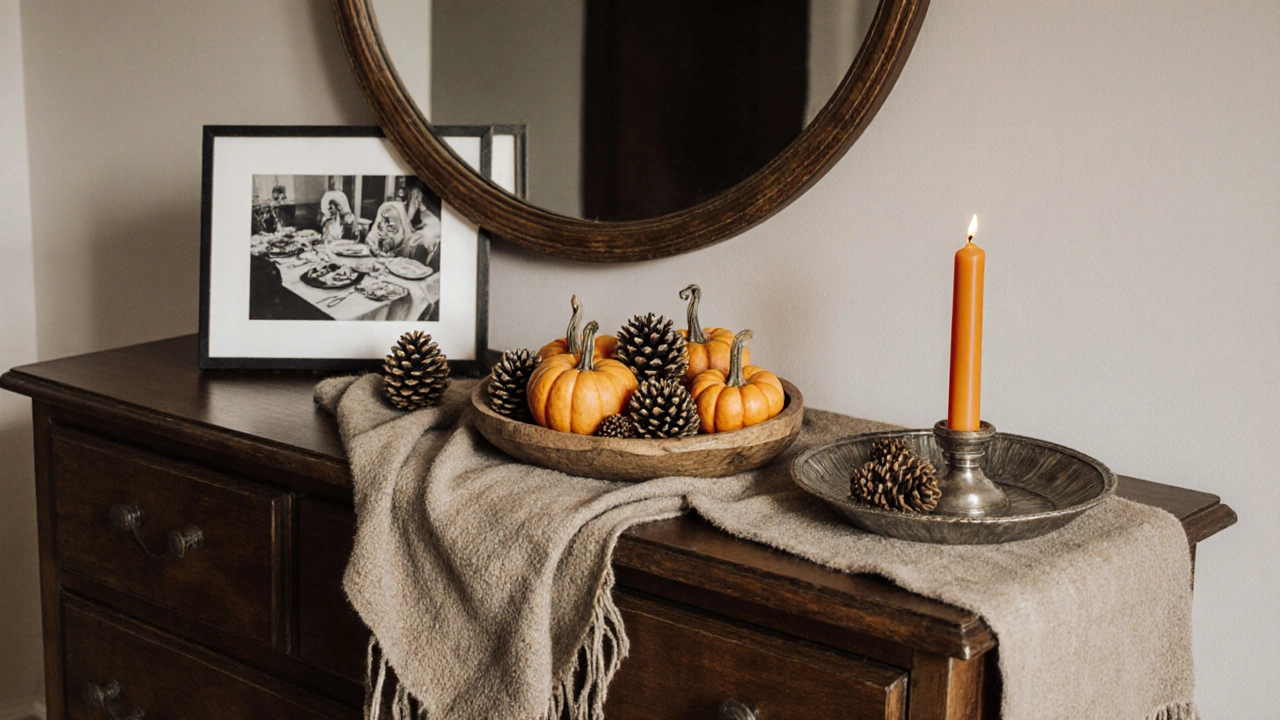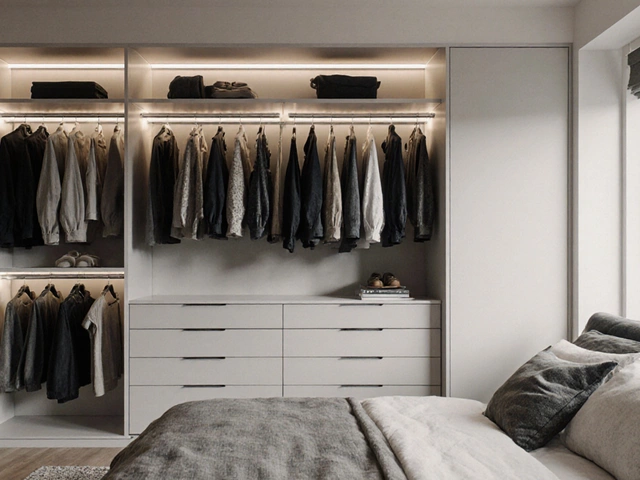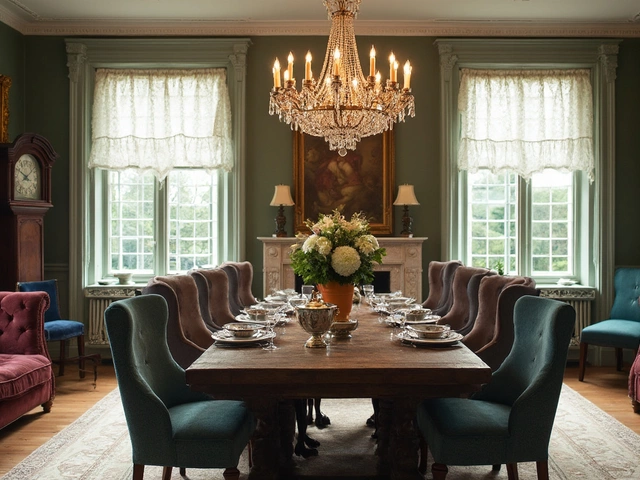Dining Room Dresser Styling Quiz
How to Style Your Dining Room Dresser
Test your knowledge on dressing room dresser styling principles from the article. Select the best answer for each question.
Most people think dressers belong only in bedrooms. But if you’ve got one sitting in your dining room, you’re not doing it wrong-you’re just missing out. A dresser in the dining room isn’t just extra storage; it’s a chance to add function, style, and personality to a space that often gets overlooked. The question isn’t whether you should put something on it. The question is: what should you put on it to make your dining room work better and look better?
Start with Function: What You Actually Use in the Dining Room
Before you think about candles or decorative bowls, ask yourself: what do you reach for during meals? If you’re digging through cabinets every time you need napkins, salt, or wine openers, your dresser can fix that. Use the drawers to store dining essentials: extra table linens, serving utensils, cocktail napkins, wine stoppers, or even reusable silicone lids. Keep the top surface clear of clutter so it’s easy to wipe down after dinner parties.One homeowner in Vancouver uses her dining room dresser as a mini bar. Top drawer holds glassware, second drawer has cocktail mixers, and the top holds a small ice bucket and a decanter. No more running to the kitchen during a party. Simple. Smart. And it turns a dresser into a conversation starter.
Use the Top Surface to Anchor the Room
The top of your dresser is the biggest flat surface in the dining room after the table. That makes it a natural place to create a visual anchor. You don’t need to fill every inch. In fact, less is more. Pick one or two items that serve as a focal point.A large mirror above the dresser is a classic move-it reflects light and makes the room feel bigger. But if you don’t want to hang anything, let the dresser itself become the statement. Choose a piece with interesting legs, a rich wood tone, or a painted finish that matches your chairs or table. Then style the top with intention.
Style It Like a Sideboard, Not a Bedroom Dresser
Think of your dining room dresser as a sideboard. Sideboards are designed for entertaining. So style it like one. Here’s how:- Place a statement piece in the center-a ceramic vase, a sculptural object, or a stack of three cookbooks with a small plant on top.
- Flank it with two matching items: a pair of candle holders, two small lamps, or twin ceramic bowls.
- Add texture with a woven tray or a linen runner. It breaks up flat surfaces and adds warmth.
- Leave at least 30% of the surface empty. Empty space isn’t wasted space-it’s breathing room.
One common mistake is overcrowding. Don’t put a lamp, a vase, a tray, a photo frame, and a candle all on top. That looks like a garage sale. Choose one hero item, and let the rest support it.
Lighting Makes a Difference
Dining rooms often rely on one central chandelier. That’s fine for overhead light, but it doesn’t create the cozy, layered glow you want for evening meals. A small lamp on the dresser adds warmth and makes the space feel inviting.Look for a lamp with a fabric shade-not glass or metal. Fabric diffuses light softly. Keep the height under 18 inches so it doesn’t block the view across the table. A table lamp with a neutral base (brass, ceramic, or wood) blends in better than something flashy. You can even use a battery-operated LED lamp if wiring isn’t an option.

Bring in Nature-But Keep It Low Maintenance
Plants make any room feel alive. In the dining room, they signal care and comfort. But you don’t need a jungle. A single succulent in a ceramic pot, a small snake plant, or a trailing pothos in a hanging planter works better than a large fiddle-leaf fig that blocks the view.Place your plant on a coaster or a small tray to catch any water. Avoid flowers that shed petals or need daily watering. You’re not running a florist shop-you’re setting a table. Keep it simple. One green thing is enough.
Use the Dresser to Display Meaningful Objects
This is where personal style comes in. Your dining room should reflect you. That doesn’t mean displaying every souvenir or trinket. It means choosing a few things that tell a story.A vintage serving platter you inherited. A set of hand-painted ceramic salt and pepper shakers from a trip to Italy. A framed photo of your family gathered around the table last Thanksgiving. These aren’t decorations-they’re memories made visible.
Limit yourself to three to five meaningful items. Group them loosely. Don’t line them up like museum exhibits. Let them feel collected over time, not bought all at once.
Don’t Forget About Storage Behind the Scenes
The top of the dresser gets all the attention, but the drawers are where the real magic happens. Use drawer dividers to keep utensils, napkins, and serving tools organized. Label drawers if you need to-especially if kids or guests use the space.Keep a small bin in one drawer for last-minute table settings: extra napkins, matchbooks, tea lights, or even a spare bottle opener. When you’re hosting, you’ll thank yourself. And when you’re not, you’ll have a tidy, clutter-free surface.

What Not to Put on a Dining Room Dresser
Some things belong in other rooms. Avoid these common missteps:- Mail or bills-those belong on the kitchen counter or home office.
- Remote controls or chargers-they’re visual noise and attract clutter.
- Large electronics like TVs or soundbars-they break the dining room’s calm vibe.
- Overly sentimental clutter-like 12 photo frames or a collection of figurines. Choose one or two.
If it doesn’t serve a purpose or spark joy during meals, it doesn’t belong on the dresser.
Seasonal Swaps Keep It Fresh
Your dining room dresser doesn’t have to look the same all year. In fall, swap your linen runner for a wool one, add a small pumpkin or pinecone arrangement, and switch to amber-toned candles. In spring, bring in fresh flowers or a pastel ceramic bowl. In winter, use evergreen sprigs or a metallic tray for holiday serving.These small changes cost almost nothing but make the space feel alive. It’s not about buying new things-it’s about reusing what you have in new ways.
Final Thought: It’s Not Just Storage. It’s Part of the Experience.
A dresser in the dining room isn’t an afterthought. It’s a quiet hero. It holds your tools for good meals. It frames your gatherings. It holds your memories. When you style it right, it doesn’t just look nice-it makes the room work better.You don’t need to spend a lot. You don’t need to follow trends. You just need to ask: what makes this space feel like home? Then let the dresser help you answer that.
Can I use a dresser instead of a sideboard in my dining room?
Yes, absolutely. A dresser works just as well as a sideboard for storage and display. The main difference is that sideboards are often designed with a more formal, furniture-specific look, while dressers are more utilitarian. But with the right styling-like adding a mirror, a lamp, and a few curated objects-a dresser can look just as intentional and elegant.
How high should a lamp be on a dining room dresser?
Keep the lamp height under 18 inches from the surface of the dresser. That way, it won’t block the view across the table during meals. If your dresser is tall, a slightly taller lamp can work, but make sure the shade isn’t wider than the dresser top. The goal is soft, ambient light-not a visual obstacle.
Should I put a mirror above the dresser?
A mirror above the dresser is a great way to add light and depth, especially in smaller dining rooms. It reflects natural light from windows and makes the space feel larger. Choose a mirror with a simple frame-wood, brass, or black metal-to match your existing decor. Avoid overly ornate styles unless they fit your overall aesthetic.
Can I put a TV on top of my dining room dresser?
It’s not recommended. A TV turns your dining room into a viewing space, not a place for conversation and meals. It adds visual clutter and distracts from the purpose of the room. If you need a screen, consider mounting it on the wall away from the dining area, or use a rolling cart that can be moved out of the way.
What if my dresser is too tall for the space?
If the dresser feels overwhelming, style it with lighter, lower items. Use a long, thin runner instead of a bulky tray. Place a small plant or a single vase in front to draw the eye downward. You can also add a small shelf or floating ledge above it to balance the vertical space. Sometimes, the problem isn’t the dresser-it’s how it’s styled.







